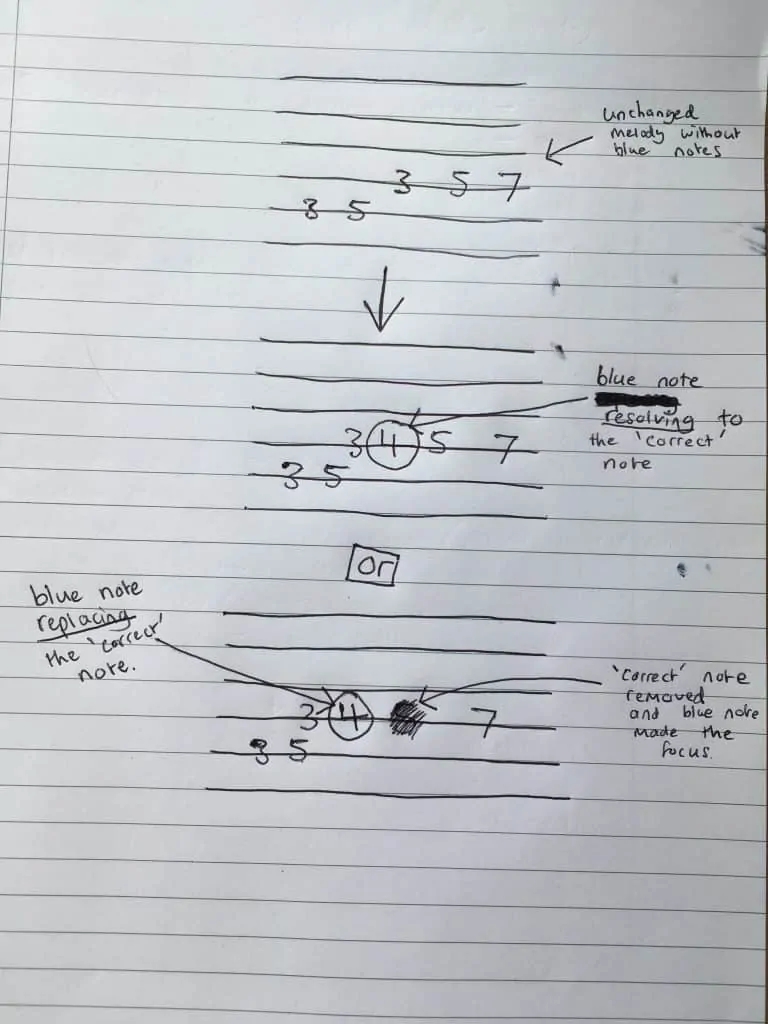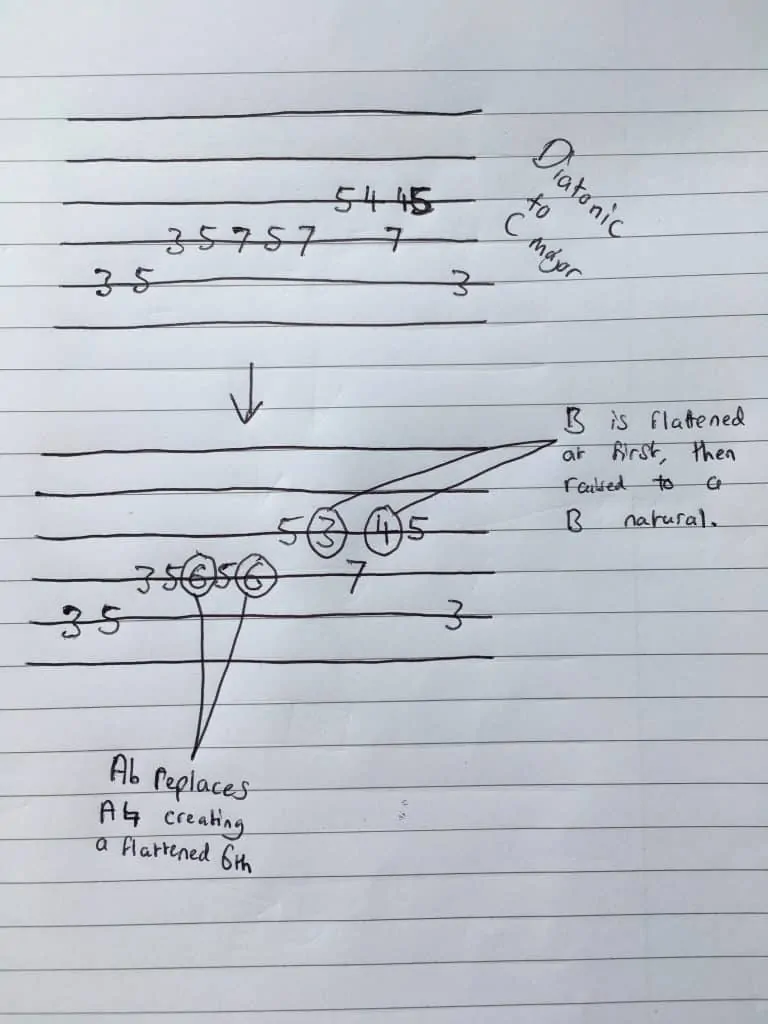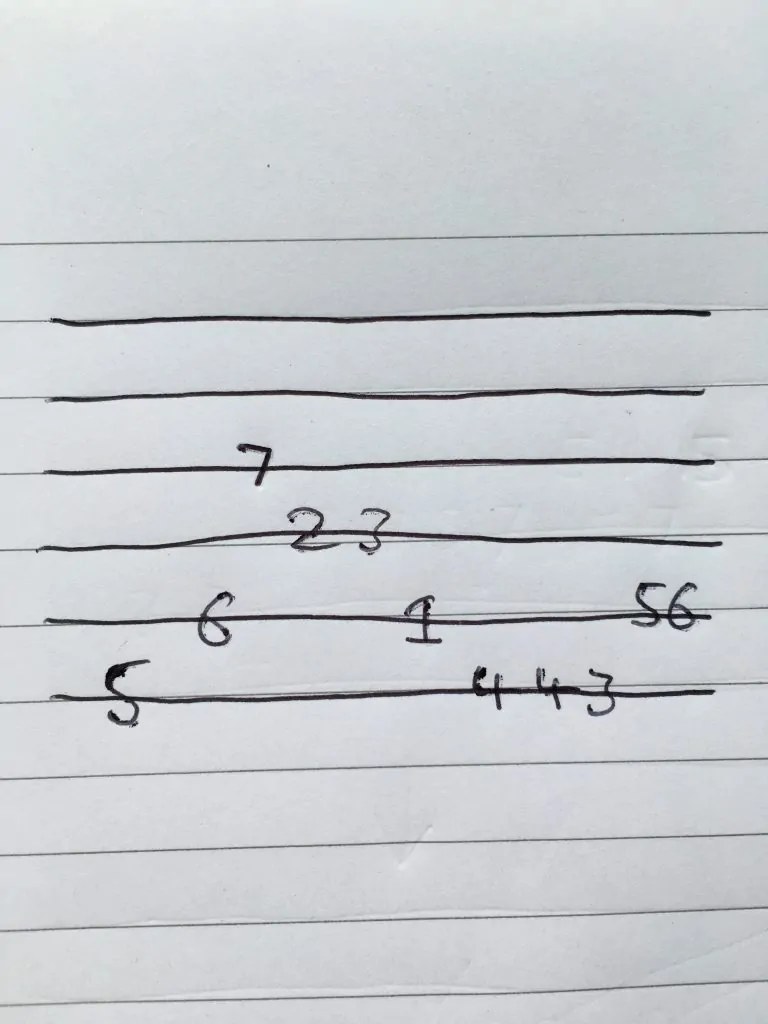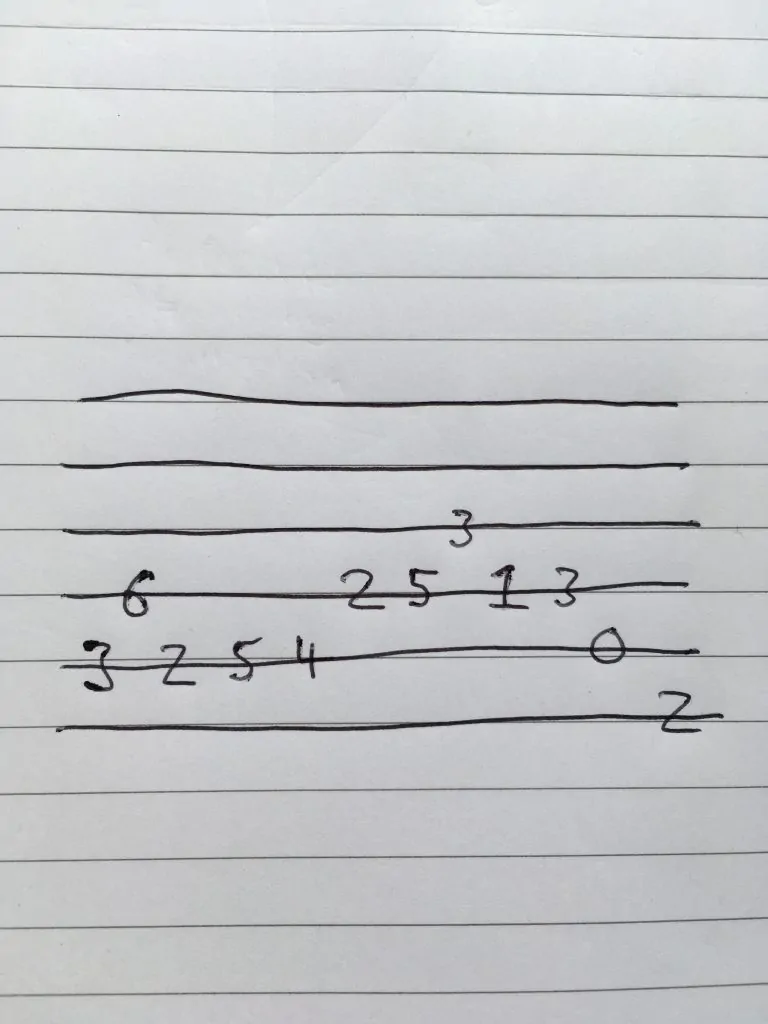A lot of melodies you’ll hear and play are diatonic, meaning they’re mostly going to sound ‘good’. However, eventually you’re going to want to add a bit of interest to what you’re playing by adding some non-diatonic notes into interesting places.
In this important guide, I’ll talk you through the process of adding chromaticism to your guitar melodies.
If you’re looking for a place to start learning chromatic melodies, then look no further…
Contents
Diatonicism V Chromaticism
Most of our guides here at BeginnerGuitarHQ are based on diatonicism. Whether you’re trying to pick up a grasp of how to play standard triadic chords or learning some beginner melodies to play on guitar, they’ll typically be diatonic to one key. If you aren’t quite comfortable with more simple ideas such as the pentatonic scale, then have a quick look here first.
This essentially means that within a scale, you’ll make your chord or melody up using notes that exclusively exist within this scale. For example, a C major scale (C, D, E, F, G, A, B) could create melodies or chords using only notes from this scale and they will be diatonic no matter how they sound. A C major triad, for example, is just as diatonic to the key of C major as a B diminished chord is, because both are made up exclusively of notes from the C major scale.
If you want to get really technical, to be diatonic is to be found within a scale that uses 5 whole steps and 2 half steps with the 2 half steps separated from each other by either 2 or 3 whole steps. This means various modes and the natural minor scale also fall into this category.
When playing dissonant (an ‘irregular’ sounding) chords, this process is a little confusing.
A chord such as the B diminished mentioned above is both diatonic and dissonant due to it being made up of notes from the same scale, but including the dissonant tritone interval. A B minor chord used in the key of C would not be dissonant, but would be chromatic as it borrows an F# from another key.
However, when looking at chromatic melodies, things are a little more straightforward. You’ll essentially just be looking out for and using notes that don’t exist in the scale you’re working with. This won’t necessarily be dissonant (because it might not be clashing with anything) but will still normally give off a distinctly unexpected chromatic sound.
If you’d like to check out a similar guide, but with a focus on dissonant chordal content, then click here.
Learning To Use Blue Notes
A blue note is, as the name suggests, mostly connected to blues. The general concept of this is simple and very effective in its use. Typically, the idea of a blue note applies to the 3rd, 5th or 7th degrees of the scale being played lower than one would expect in the scale. Slightly more complex, is the fact that this could theoretically apply to a microtonal difference… but we’ll come back to that.
In the example below, I’m demonstrating how a melody can go from simple diatonicism with every note being clearly in its key. A blue note (the 4th fret of the 3rd string in this case, which is a lowered 5th [AKA Gb) of the C major scale the example is using) is added to both examples.
Using Blue Notes As A Passing Note
The first example shows the blue note acting as a chromatic passing note. This means that you hear both the notes either side of it, with the chromatic note being used to get between the two. This shows the 5th being flattened and then sharpened again for the second time it is heard. This is a relatively simple idea and you probably use this more than you think naturally in your playing.
In order to pull it off successfully, you can simply use your 2nd finger to press down the 3rd fret, then your 3rd to hit the passing note, then land on your 4th finger for the 5th fret. This technique can also get you out of a sticky situation if you hit a wrong note; simply slide up by a semi-tone and you’re likely to be back in the right key and it’ll seem like you were playing a particularly emotive solo.
Using Blue Notes As A Replacement Note
This is a slightly more extreme version of the blue note as it replaces the entire note with a chromatic alternative, without resolving up to the diatonic note. As the second example shows, the 5th fret note (G) has been completely replaced by the 4th fret Gb. This means we now make the chromatic move from the 4th to the flattened 5th without ever reaching the diatonic 5th. This is a slightly more dissonant way of playing, but in the context of jazz and blues can very often sound perfectly emotive and legitimate.
While this is a bit more theoretically complex, the performance of the technique is much easier. You can basically play the second example in the same way you’d play the original melody, just make sure to hit the 4th fret with your 3rd finger rather than the expected 5th fret.
Using Blue Notes Microtonally
On a standard guitar, you can only achieve microtonal movement through bends (or some severely questionable tuning methods). In western systems, a microtone can be reduced down to ‘cents’, which divides a note into 100 equally spaced microtones. Unless you’re working with some exceptionally complex 20th century repertoire, there is no need for you to ever think about how many cents your note is bent to.
However, bluesmen and rockers alike are very much accustomed to bending their strings. In fact, every bend you make is almost always going to have a microtonal quality, as it would be very difficult to bend to a specific cent, it would just be so hard to hear these small increments that you just wouldn’t notice. With microtonal blue notes, you’ll normally bend to roughly a quarter tone (which is essentially half a semitone AKA directly halfway between each fret).
To pull this off, you’ll want to play any note you want and just give it a slight bend that takes it to a place that isn’t quite as high as the fret directly above the note you’re bending. Its best to do this with feeling and attack it without a specific theoretical ideation as it’ll feel much more natural. In most situations this bend will act as a passing blue note, because you’ll bend the string back to its original place after.
It can also be used to bend a string up to a diatonic note from a dissonant note. For example, if you play a very slightly bent 4th fret on the 3rd string (EG a G half flat) and bend it until it sounds the same as an un-bent 5th fret, you’ve used a microtonal blue note to resolve up to a diatonic note.
A Few Examples Of The Use Of Blue Notes:
- Pink Floyd- Echoes. The opening minutes of this 20 minute track show David Gilmour bending his slide guitar every which way. Almost every note he plays has some blue notes allowing chromatic inflections to seep into his highly emotional playing. You’ll hear straight away that this gives it a soulful feeling, while still sounding very pleasant but not boring and samey. Give it a listen here.
- BB King- The Thrill Is Gone. Everyone knows BB King as one of the greatest blues guitarists of all time, thanks to his tone and emotionally charged playing. A lot of his best pieces of improvisation come fully loaded with bends which demonstrate both classic passing chromaticisms and microtonal bends. Give it a listen here.
- Pharrell Williams- Happy. This track might be a surprising addition to the list as we all know it to be a ‘simple’ chart pop track. However, this both shows what a clever track it is, while also demonstrating how natural and impressive blue notes can sound when employed properly. This track is littered with blue notes that sometimes even clash with the harmony below them. He flattens 3rds, 5ths and 7ths all the way through, with this guide talking you through it if you’re looking for a bit more detail. Give it a listen here.
- Radiohead- How To Disappear Completely. While the microtonality found in this track isn’t necessarily blue notes by definition, it can help you be a bit less scared of what can be a daunting concept. Listen to the strings; they aren’t using a standard western tuning system and it still brings the track alive. Don’t be scared to bring in similarly microtonal bends into your melodic playing. Give it a listen here.
Well-Placed Chromaticism In Melodies
Not all chromaticism has to be in passing or used as a blue note. Sometimes a moment of playing that moves outside of the key we expect can sound particular bold and unique. While a non-passing blue note is technically an example of a well-placed piece of chromaticism, these will typically be moved away from pretty quickly, used for emotional effect and be a flattened 3rd, 5th or 7th.
In this scenario, I want to explain how chromaticism of any kind can be well placed, sustained and used to create tension or even a moment of unexpected beauty.
The example below demonstrates a series of notes diatonic to C major (C, D, F, G, A, G, A, C, B, A, B, C, C). They sound fine, but the melody itself is nothing special. Underneath, we have a melody which also centres on C major, but includes a few chromatic alterations which bring it a new lease of life. This one is made up of: C, D, F, G, Ab, G, Ab, C, Bb, Ab, B, C, C).
The first change brings the A naturals down to A flats. In the key of C major, this is a flattened 6th. This creates a much more ‘epic’ sound in the rising melody, as it makes the note you’re expecting to hear slightly lower, yet still very pleasant, as well as much more interesting. The use of the flattened 6th is particularly common in film scores, such as John William’s ET score.
The second use of chromaticism comes towards the end of the melody, where the first B is replaced by a Bb while the second reverts back to being a B natural. This shows how chromatic notes are able to alternate between different versions of themselves, even within one melody. This creates a sound which imitates the melodic minor scale, which has a flattened 7th when descending, and a raised 7th when ascending, making the final note sound like a leading note in a minor scale.
On top of this, the melody (aside from the G and the final B natural) suggests the use of the whole tone scale, a non-diatonic scale in itself, based exclusively on whole tone leaps.
Other approaches to non-passing chromaticism are built on the use of well placed notes. You need to be aware of what you’re playing over. For example, if playing over a major triad, then sustaining a flattened 7th above this will create the sound of a dominant 7th chord and has a high chance of sounding like it works. On the other hand, playing a flattened 3rd over a major triad is going to create a major/minor dissonance, which rarely works in a pleasant way. If you’re going for tension or aggression, then this is perfect, but if you need a beautiful solo then maybe figure something else out.
When playing in this style, your positioning of your fingers can change at a moments notice. Because of this, it’s pretty hard for me to give you concise and specific tips. However, one important suggestion is to play your chromaticism with meaning. If you’re playing a fast and loud section and you pause slightly and play your chromatic note quieter, it’s going to sound like a wrong note. Keeping it in the same context as the rest of your playing is going to make it confident and exciting in its sound. You can learn how to do this with our guide here.
A Few Examples Of Well Used Chromaticism:
- Yes- Close To The Edge. The opening to this track is one of the best examples of chromatic playing in music. It might seem at first like some sort of random composition, but Steve Howe’s playing is meticulously composed and crafted in a way that makes every chromatic note seem purposeful and important. Give it a listen here.
- Opeth- Ghost Of Perdition. Almost all of Opeth’s riffing is built on chromatic melodies which show off a deep understanding of where chromaticism can be added to melodies for effect. Take the opening riff from this song, for example, which uses dissonant intervals and jumps to create an intense, heavy sound. However, also listen for how they use chromaticism in the harmonisation of their guitar lines. This create an intentionally grating, dissonant sound which happens to also sound incredibly cool. We’ll look at dissonant harmony in more depth here. Give it a listen here.
- Slayer- Angel Of Death. While Kerry King’s solo on ‘Angel Of Death’ may seem like a manic exploration of atonality, listen closely and you’ll hear that there is a central key amongst all of that chromatic decoration. In this case, he is using chromaticism to give his playing a highly tense, aggressive and almost scary sound that suits the aggressive thrash metal Slayer play. If this is your genre, take notes on his use of chromaticism. Give it a listen here.
The Use Of Atonality And Serialism
We’ve looked at a lot of pretty simple chromaticism that will fit many melodies, but there are types of chromaticism which are unexpectedly dissonant and unusual. While atonality and serialism aren’t the same, they do overlap.
What Is Atonality?
The general definition of atonality is a lack of traditional tonality. This means your playing isn’t restrained to a scale and therefore diatonicism is an essentially irrelevant term here. It would be incredibly hard to make your atonal playing sound ‘good’, but it could certainly sound tense, chaotic or ugly if this is what you’re looking for in a performance.
The example below shows a melody with no basis to one particular key or note. The notes used are: A, Eb, D, E, F, C, A, Ab, G, D, Eb.
Because there is no note drawing any sort of pull, this is an atonal melody. At the same time, because certain notes to appear more than once, this isn’t a serialist melody (we’ll come to that in a minute).
When playing this style, be careful note to accidentally hit dud notes which may take away the confidence of your atonal jam, but at the same time, don’t worry about hitting ‘wrong’ notes, because technically they might all sound ‘wrong’.
What Is Serialism?
This is a much more refined, theoretical and complex technique. The overarching idea of 12-tone serialism is to give absolutely no hierarchy to notes. This means every note heard has to be played before the same note can be heard again.
In this example, we start on a C, but cannot return to the C until every other note of the chromatic scale is heard. This, as you might expect, creates an incredibly dissonant sound. The tone row used in this example is: C, Ab, B, D, Db, E, G, Bb, Eb, F, A, Gb.
In improvisation, this would be an incredibly hard skill to employ as you’d need to keep up with every note you’ve already employed. However, in pre-composed music, it gives a complex edge to work that needs a certain level of intensity and drama. Obviously, aside from highly skilled composers of progressive and experimental music, you aren’t going to hear this in popular repertoire.
A Few Examples Of Atonality And Serialism:
- Frank Zappa- Brown Shoes Don’t Make It. This track is already known for its polystylistic experimentations, but it is also frequently atonal. Zappa’s playing itself is typically quite atonal (and also sometimes uses a method of free tempo called xenochrony) and his expressive examples in this song are up there with his best. Give it a listen here.
- Anton Webern- Kinderstück. Under the tutelage of Arnold Schoenberg, the developer of the serialist technique, Anton Webern wrote some of the most mind bending serialist work around. This piece demonstrates the technique in all its seemingly random (but meticulously pre-determined) glory. This shows how dissonant and unpleasant this style sounds, but with this being the complete intention behind it. Give it a listen here.
In Conclusion…
The idea of chromaticism isn’t too hard to get your head around, and the more simple ideas such as blue notes aren’t difficult to bring into your music. In most styles, this is all you’ll really need to create a more interesting sounding and emotional driven melody. Master this and you’ll be set.
However, if you’re looking to move deeper into the more experimental realms of music, then you might need to look into the ideas like serialism and grasp some of the theory with more detail before you attempt to pull it off well.

Dan is a music tutor and writer. He has played piano since he was 4, and guitar and drum kit since he was 11.
He plays a Guild acoustic and a Pacifica electric. He has been sent to many festivals and gigs (ranging from pop to extreme metal) as both a photographer and reviewer, with his proudest achievement so far being an interview he has with Steve Hackett (ex-Genesis guitarist).
He ranks among his favourite ever guitarists, alongside Guthrie Govan, Jimmy Page, Jimi Hendrix, David Gilmour and Robert Fripp. His favourite genre of music is progressive rock, which he likes to use as a reference point in my teaching, thanks to its huge complexity in structure, rhythm and harmony. However, he is also into a lot of other genres including jazz, 90’s hip-hop, death metal and 20th century classical music.




